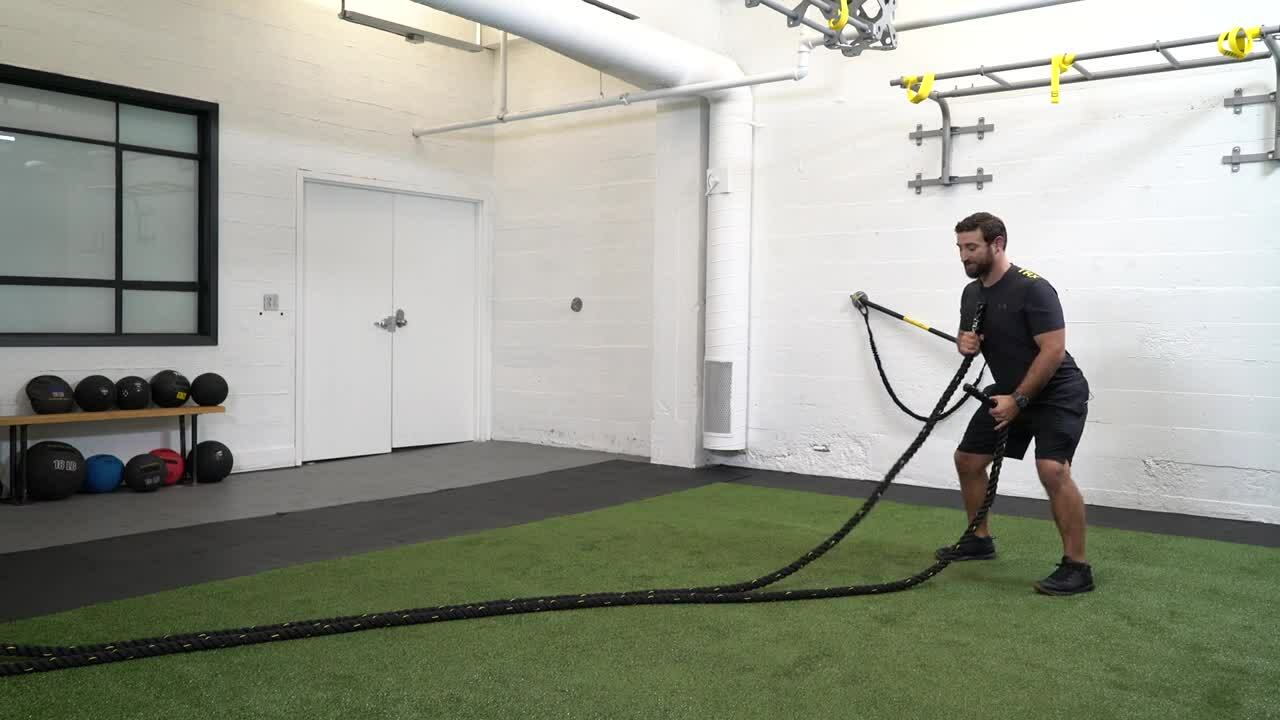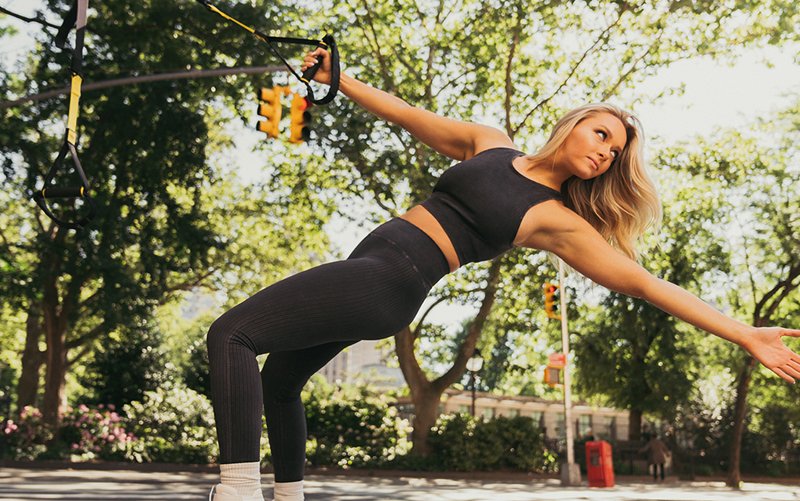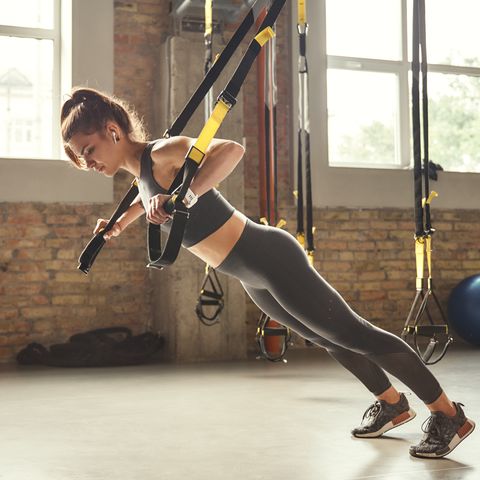Dad's are men of many hats. Take our quick fitness assessment quiz for age-appropriate exercises to keep you strong for every parenting moment. Dads practice soccer with their tweens, delight flying toddlers in the "airplane" game, and launch 60lb kids through the air from swimming pools. Dads shuffle-run the baseline while wildly waving young sluggers through to home plate. Dads cradle whaling babies, crying children, and sobbing teenagers. Dads radiate a strength that mere mortals can only dream of. And if you're looking for a way to tone up your body and stay action-ready for whatever surprises your kids may bring your way, this Battle Rope Circuit will do the trick.
TAKE OUR TRAINING QUIZ
Battle ropes are one of the unsung heroes of fitness. Battle rope exercises may look easy—Wave your arms up and down? No problem!—but those simple movements deliver a full body strength and endurance challenge. With proper form, battle ropes work your anterior and posterior chains, legs, upper body, and core, all while getting your heart racing. (Men’s Health even named battle ropes exercises one of the ten exercises that burn more calories than running.)
The TRX Battle Rope Difference
When purchasing battle ropes, remember that not all products are the same. TRX Battle Ropes are designed with comfortable rubber grips, and the heavy duty tightly-braided construction can survive even the toughest of battle rope circuits. Available in both 30 and 50-foot lengths, you can find the right size rope for your workout space.
The Battle Rope Circuit
High intensity interval training (HIIT) is one of the most effective ways to burn calories and tone up a dad bod, and battle rope movements mesh perfectly with this style of exercise.
For this workout, we’re going to keep the format simple with a Tabata circuit, which means that you’ll be exercising in four-minute blocks with two distinct intervals: 20 seconds of activity, followed by 10 seconds of rest.
After eight, 20-second rounds, you’ll get a short break to grab water, towel off the sweat, and reset. We’ll be combining both TRX Battle Ropes and bodyweight exercises, but you could also mix things up by substituting exercises on your TRX Suspension Trainer for the bodyweight movements.
There are six different exercises in the circuit, and we suggest taking a 45-60 second break after each four-minute Tabata round. You can run through the circuit once for an approximately 30-minute workout, or twice if you want to train for a full hour.
Let’s get started!
Battle Rope Double Arm Wave
For this exercise, you’ll start standing facing the anchor point—which is wherever your rope is anchored, whether it’s a tree, pole, or TRX Xmount—and hold the handles of the rope with both thumbs facing up. (Pro-tip: Keep a little bit of your palm on the rope to ensure your grip doesn’t slip when your palms start sweating.) As you start, maintain an athletic, squatting position, with your feet planted slightly wider than hip-distance apart. Your hips should be back and your chest should be up. We’ll come back to this stance again, so make sure you nail it.
Your arms will be moving simultaneously for these double arm waves, so think of lifting both handles overhead at the same time, and then pulling the handles down and back—similar to how you would use ski poles. Repeat this motion quickly for the duration of each 20 second interval.
Squats or TRX Squats
For our second move, we’re giving the arms a break, but keeping the fire in your legs. With or without your TRX Straps, you’ll begin with your feet planted about hip-distance apart, and your weight set in your heels. Lower down into a seated position, then drive back up through your heels to a tall, standing plank.
If you want to try the TRX Squat with your Suspension Trainer, you’ll begin in roughly the same way. Stand facing the anchor point with the straps adjusted to mid length, and remember that your palms should be facing down while gripping the Suspension Trainer handles.
With either the squat or the TRX Squat, jump squats get bonus points and are always encouraged!

Battle Rope Alternating Waves
For our Battle Rope Alternating Waves round, you’ll once again start standing, facing the anchor point in your athletic position, with both hands grabbing the rope and your thumbs pointing up to the sky. With every movement, you’ll be lifting the rope up, and then pulling it back, alternating between arms. This is a quick, fluid movement; when you get it right, your ropes should look like rolling waves—similar to how wavelengths are depicted in science.

Split Lunges
We’re back to dynamic leg movements for your fourth round, with either a split lunge or a TRX Split Lunge.
In this move, you’ll start in a kneeling position, with your left knee in front at a 90-degree angle and your right knee behind, hovering just above the floor. Pressing through your front left heel, blast up into a hop, and switch legs. As you land back into that kneeling position, your right leg should be forward and your left knee should be back.
You can either do this as a bodyweight split lunge, pumping your arms back and forth with every jump, or you use your TRX Suspension Trainer for support. If you’re using the Suspension Trainer, you’ll begin standing facing the anchor point with the straps at mid-length, and your palms facing down. As you jump and switch legs in the lunge, press your palms into the Suspension Trainer handles, which will make the hop/switch transition a little easier.
Battle Rope Side Plank Slam
For this exercise, you’ll start in a forearm side plank facing the anchor, holding just one of the TRX Battle Rope handles in your top hand. Just as you’ve done in the previous two ropes exercises, you’ll be lifting up and pulling back the handle, but this time you’ll have the added core stability challenge. Keep the rope moving in the same wave pattern you’ve been chasing in the previous ropes exercises. After each 20 second round, remember to switch sides. At the end of the four minute round, you should have completed four, 20-second rounds on each side.

Push-Ups or TRX Chest Press
Your final exercise is a classic: push-ups! Whether you choose to start from your knees or toes, this one will complete the burn of your full body circuit.
Begin in a plank position with your palms planted just beyond your shoulders. To make this move more accessible, start with your feet set wider apart; to make it harder, bring your feet closer together. Drop your plank down by bending your elbows, and drive back up to straight arms to reset the push-up.
If you prefer the TRX Chest Press alternative, you’ll fully lengthen your straps. Start standing facing away from your anchor point with your palms facing down. As you descend into the TRX Chest Press, your elbows should come to 90-degree angles at your sides, and your body should remain in a plank. To make the TRX Chest Press more challenging, set your feet closer together, or take a step back; to make the move easier, set your feet hip-distance apart or take a step forward.
The best thing any dad can do for himself and his kids is to stay healthy, and regular strength and cardio workouts are an important part of any wellness plan. Hit the gym, or bring the gym home: it’s up to you. But with this fast, efficient battle rope circuit, you can take care of your health and then get back to hanging with your kids.



